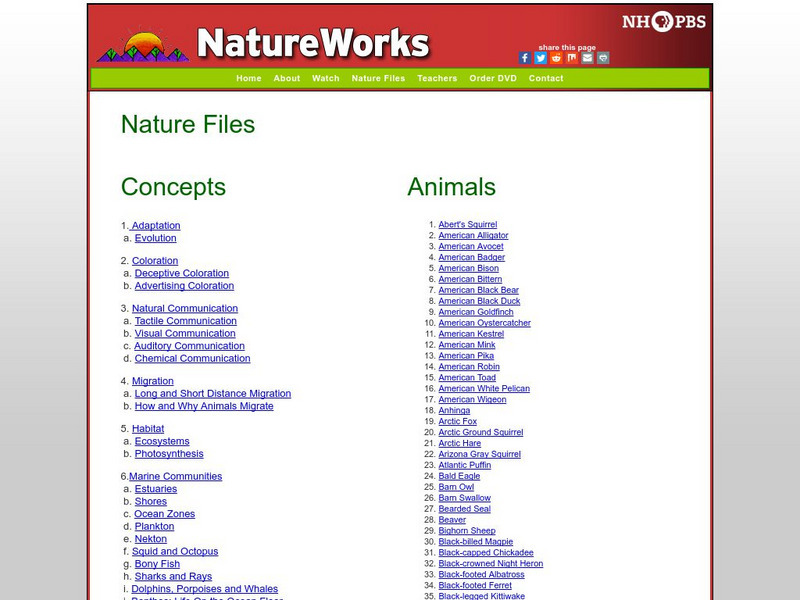Hi, what do you want to do?
Curated OER
Biomes of The World
Students research different biomes, using links from global pen pal letters.
Curated OER
Extensions - Biology Review Unit
Young scholars engage in a variety of activities in order to review a Biology unit. For example, they research the Bird Flu, it's history, how it is spread, what has been done about it, what better options exist for controlling or...
Curated OER
Our Environment
Students engage in a literature study that helps students to connect with some of the issues of conservation. They list parts of the environment that need protection with the help of a graphic organizer. Then students discuss in groups...
Curated OER
Ozone Pollution: Smog Alert
Students examine factors the create smog. In this pollution activity students complete an activity about ozone.
Curated OER
Living in a Community
Students understand the differences in communities by reading "City Mouse, Country Mouse" by Isabelle Chantellard. In this types of communities lesson, students find that although communities are different, one is not better than the...
Curated OER
Ecology Vocabulary Exercise: Wetlands
In this ecology vocabulary exercise: wetlands worksheet, students read the definitions of 8 words, then categorize a species found in a wetland in their region. This page has numerous links to helpful web resources.
Curated OER
The Roanoke Mystery
Fourth graders hypothesize about what happened on the island of Roanoke. For this South Carolina history lesson, 4th graders use primary documents to draw conclusions about what happened to the Lost Colony of Roanoke. This mini-unit...
Curated OER
Food Webs
Fourth graders discover how organisms depend upon each other in an ecosystem. In this ecosystems lesson, 4th graders use food webs to discuss the interdependence between organisms in an ecosystem.
Curated OER
Sow Bug Habitats
Students conduct an experiment to determine what type of environment sow bugs prefer. They use petri dishes with partially wet paper towels to assess whether they prefer wet or dry habitats.
Curated OER
Seasonal Changes
Students examine wildflower data compiled from their student journals from the school year. They determine patterns of seasonal growth then use these patterns to predict patterns for missing data.
Curated OER
Super Scientists Bingo
In this science worksheet, middle schoolers select twenty-five scientists from the list to fill in their bingo card. Then they match each of the scientists listed to their correct description strip.
ReadWriteThink
Read Write Think: Nature Reflections: Interactive Language Practice for Ell
Detailed lesson plans and materials designed for ELL/ESL students that has them observing, discussion and writing about, and from the perspective of, plants and animals. Students create a book (may be bilingual) to be reviewed by peers....
Alabama Learning Exchange
Alex: Little River Canyon's Carnivorous Green Pitcher Plants
A digital slide program introduces the Green Pitcher Plant (Sarracenia oreophila) to the students. Students use a model of the Green Pitcher Plant and plastic insects to role play. They will tell the story of habitat adaptation and...
PBS
Pbs Learning Media: The Columbian Exchange
In this interactive lesson supporting literacy skills, students watch video dramatizations that tell the story of the Spanish explorers who arrived in the Americas with Columbus and introduced European, African, and Asian plants and...
PBS
Pbs Learning Media: Animals and Plants Can Live in a City!
In this interactive lesson, students learn that animals need air, food, water, and shelter, while plants need air, sunlight, and water. Students watch videos and engage with drawing and sorting activities to reinforce their learning....
PBS
Nh Pbs: Nature Works: Nature Files
Resources to accompany a 16-episode science series created to help young minds better understand how plants and animals interact with their environment. A fantastic resource for elementary science teachers that includes state standards...
TeachEngineering
Teach Engineering: Biodomes
Students explore the biosphere's environments and ecosystems, learning along the way about the plants, animals, resources and natural cycles of our planet. Over the course of lessons 2-6, students use their growing understanding of...
Environmental Education for Kids
Eek!: Habitats: Forest
Forests are more than just trees. They are a complex community of plants and animals that constantly change, grow, and interact with each other and the nutrient-bearing soils upon which they depend. Read about some of the many plants and...
PBS
Pbs Kids: Eekoworld
Interactive website from PBS Kids teaches students age 6-9 about a number of ecological topics and the role they play in protecting the environment. Topics include recycling, the environment, air and water, plants and animals, and the...
American Museum of Natural History
American Museum of Natural History: Habitat O Logy Card
Flip this interactive OLogy card to find fast facts, questions and answers, and other bite-size pieces of information about the meaning of habitat, as a scientific concept, and learn why habitat is so important to plants and animals.
PBS
Pbs Learning Media: Acid Lake
Students will add acidity to a healthy lake to see what happens to plants and animals in this interactive activity adapted from EcoKids.
Other
Yahoo! Japan: Multimedia Zukan Encyclopedia
Japanese content! Includes search and browse function to research animals, insects, plants, and birds by names and glossary. Video and audio available as well.
Other
Suny Stony Brook: Spartina Salt Marsh Ecology
Good illustrated introduction to Spartina salt marsh ecology. Focus on the grasses and their interactions with each other and the animals that inhabit the marsh.
Other
Appalachian Trail Conservancy
The Appalachian Scenic Trail stretches from Georgia to Maine. Initially an idea in 1921 and completed in 1937, the trail has so far endured an official 10,000 hikers, with many more to come. Get the history, plant and animal life, and...























